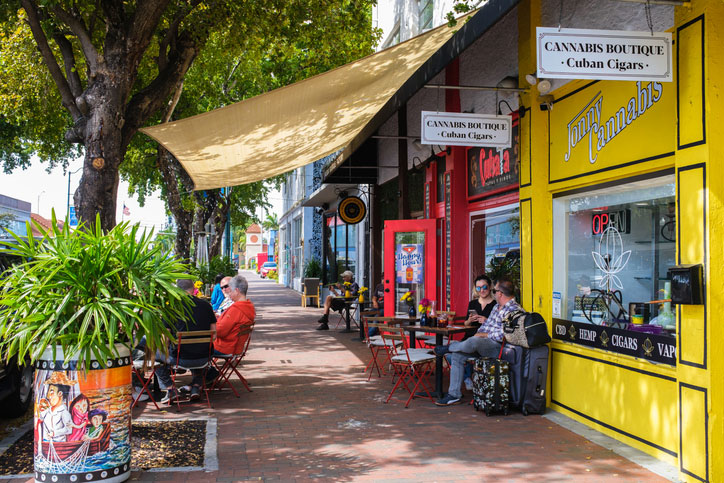Written by Scott Wilson

While this is a hot button topic in social work circles, the fact is that anyone in the Sunshine State already has a head start when it comes to cultural competency. You don’t get far in any kind of job in Florida without a little bit of cultural humility. As one of the most diverse states in the union, there’s no way to get through a day without rubbing shoulders with a beautiful and breathtaking array of the world’s languages and cultures.
So it’s absolutely true that every social work student, and even plenty of licensed social workers here, can stand to put a little extra time and effort into cultivating cultural humility. And, just as you’d expect, it’s just about the perfect place in the world to do it.
Florida Has Been Embracing Multiculturalism for Generations

It’s worth taking a step back and looking at just how colorful and multicultural Florida really is.
According to the 2020 Census, we’re the third-most populous state in the country. Most counties showed an increase over the 2010 Census; during that same period, the diversity index increased from about 55 percent to about 64 percent.
Most Floridians are from elsewhere; only around a third of state residents surveyed in the 2022 American Community Survey by the Census were actually born in Florida.
Barely over half of residents identify as white, while more than a quarter are of Hispanic or Latino origin and around 14 percent Black.
The Census doesn’t fully account for national origins, but it’s clear that Florida is a thriving home for thousands of individuals and families who immigrated originally from:
- Cuba
- Other Caribbean countries like Haiti, the DR, Jamaica, and smaller islands
- Central and South America, including Mexico and Columbia
- Eastern Europe
All in all, over twenty percent of the population is foreign born, much higher than the national average.
Florida Social Workers Face Unique Cultural Dynamics
 It’s sort of baked into most of the literature that cultural competency is something that is mostly for cis-white folks from the cocoon of a suburban upbringing who will be engaging with BIPOC or LGBTQIA2S+ populations that are unfamiliar to them.
It’s sort of baked into most of the literature that cultural competency is something that is mostly for cis-white folks from the cocoon of a suburban upbringing who will be engaging with BIPOC or LGBTQIA2S+ populations that are unfamiliar to them.
There are plenty of white people and plenty of suburbs in Florida, it’s true, but like the rest of the country, the expanding social work workforce isn’t primarily coming from those places.
Instead, according to 2020 data from the Council on Social Work Education and the National Association of Social Workers, new social workers are predominantly women and are racially and ethnically diverse. Some 90 percent of MSW grads between 2017 and 2019 were female. Nearly a quarter were Black, and 14 percent were Hispanic or Latino.
At the same time, many of the clients of Florida social workers are older white transplants from cold northern states who seek paradise in retirement. The cultural dynamic here may be unpredictable, with social workers who are themselves part of marginalized groups learning how to connect with life-long New Yorkers who have moved south and now need help with healthcare or mental health resources.
So cultural humility for Florida social workers may take some unusual paths that not all training will account for. But the basic elements of respecting individual dignity, lived experience, and developing personal empathy will work no matter who you are or who your clients may be.
Florida also has cross-cultural dynamics that aren’t found in most other states. The amazing weather draws an estimated million or so snowbirds down from states across the frigid northern tier of the country each year. These temporary residents, who stay for only a few months, contribute their own cultural backgrounds and biases to the overall culture of the state. Most are retired, which also puts them in the demographic that many social workers engage with for healthcare, geriatric services, or mental wellness.
While state cultures aren’t something you typically think much about when thinking about cultural competency, it’s a real thing to adjust from Florida Zest to Midwest Nice when working with these clients.
The many waves of immigrants that have come to call Florida home over the generations, from Cuba and Latin America and the Caribbean, but also from Europe and Africa bring a diverse mix of culture together here. But none of these cultures are one demential. While their national origins may be shared, you can find plenty of cultural differences between generations within these populations.
So cultural competency is something that Florida social workers have to live and breathe.
Fortunately, there are plenty of resources and local experiences to help you get your rhythm.
Putting the Brakes on the Stop WOKE Act
 As if Florida social workers weren’t already dealing with enough challenges, the state’s 2022 Individual Freedom Act, better known across the country as the Stop WOKE act, attempts to limit your options for cultural competency training.
As if Florida social workers weren’t already dealing with enough challenges, the state’s 2022 Individual Freedom Act, better known across the country as the Stop WOKE act, attempts to limit your options for cultural competency training.
Stop WOKE doesn’t apply to individuals, so you are free to pursue any studies in cultural humility you choose on your own. But it does seek to impact public and private employers, as well as schools, so any on-the-job training you might receive in cultural competency could be limited.
The law flags 8 concepts that cannot be taught in required training, or even actively promoted through work activities. Needless to say, a number of these are controversial and almost all are ambiguous, leading to great confusion over what is and is not allowed.
Thankfully, as of late 2024, a permanent federal injunction blocks parts of Stop WOKE from applying to employers, but another level of appeals could be pursued if the state chooses to do so.
Cultural Competency Resources Available to Social Work Students and Professionals Across Florida

While it’s perfectly normal and historically the rule that certain populations have tended to settle in certain areas around the state, Florida will forever be a welcoming home to ethnic and cultural groups, from Key West to the upper Panhandle in cities, towns, and suburbs.
So both building cultural competency and exercising cultural humility are ongoing projects for social workers everywhere in the state. These resources can help you develop your awareness even further as you work to become an effective ally – the perennial role of every social worker.
Florida Center for Cultural Competence
Specializing in diversity and inclusion training and cultural humility development for organizations, FCC also offers live-stream courses and online self-study PDF downloads available to anyone, including social work students. Importantly for the unique context of Florida social work practice, they also have a Spanish language course in intercultural competencies for sexual and reproductive healthcare.
Florida Alcohol and Drug Abuse Association
Part of the Florida Behavioral Health Association, FADAA joined with the Florida Department of Children and Families to put together a list of culturally competent practice resources aimed at practitioners working with youth and families to address substance abuse issues. This is a common niche in social work practice for the state, but many of the resources also offer more general cultural sensitivity training that could be useful to any Florida social worker. Available in printable reports, as websites, or as recorded training webinars, there is plenty to dive into here.
Division of Arts and Culture – Florida Department of State
There’s no better way to learn any culture than through its expressive arts, and the Florida Department of State Division of Arts & Culture offers a window into all of Florida’s amazing cultures. From the vibrant beat of the Latin music that thumps through streets across the state to the folk arts that have been kept alive in the swamp settlements around Lake Okeechobee for hundreds of years, you’ll find pointers to diverse examples of all the cultural blends that make Florida great.
National Association of Social Workers
Although Florida is a more multicultural hotspot than much of the country, the challenges in cultural competency here aren’t new in the world of social work. So it’s always worth looking toward the ultimate umbrella in American social work diversity, NASW. Somewhere, every problem you might confront in developing your own cultural humility for practice anywhere in Florida has already been seen, dissected, and turned into a set of lessons learned. You can find them through the extensive continuing education resources, presentations, and webinars available on the NASW site.
National Association of Social Workers – Florida Chapter
Of course, local knowledge is always appreciated, which is why the Florida chapter of NASW can provide even more resources and guidance in making cultural adjustments to your practice here. The annual conference offers not just fellow social workers to bounce your challenges and ideas off of, but a vast lake of multiculturalism itself to engage with and learn from.
Although you probably already have a leg up in cultural competency simply by studying and practicing in this multicultural state, the key to cultural humility is knowing that there is always more to learn.
As you progress through your social work career, keeping an open mind and an open heart will remain your best tools in understanding and connecting with clients from every culture under the Florida sun.
Ethnic Enclaves Around Florida Offer Exceptional Opportunities for Social Workers to Learn and Acculturate

Just like you find anywhere in the country, all these various ethnic and demographic groups tend to cluster in certain areas. And one of your best options to really get into the cultures you will be working with every day is to get out and experience the kind of lives they lead and activities they celebrate from day-to-day.
These are some of the best places to find that kind of multicultural mingling.
Jacksonville
Jacksonville, covering almost 875 square miles, is the largest city by area in the United States. That leaves it plenty of room for various pockets of ethnic diversity. Its historical status as a major deepwater port and naval base have also made it a place where many waves of immigrants have come in over the years.
The Eartha M.M. White Memorial Art and Historical Resource Center can give you a window into the almost 30 percent of the population here that is Black. Part of the Clara White Mission, an organization that today combats homelessness, the museum celebrates the music and arts that the local Black community has revolved around since the early 1900s.
Jacksonville also happens to be home to the largest Filipino community in Florida, a legacy of U.S. Navy recruitment of Filipino mess stewards in the early part of the last century that were brought here courtesy of Naval Station Mayport. Since then, the climate and familiarity led many of the new American citizens to settle here. Today, that’s a legacy you can find in Filipino Pride Day, or FPDJAX, and in the many truly mouthwatering Filipino restaurants here.
Clay County, south of Jacksonville, is home to one of the larger Eastern European Jewish communities in the state. This suburb brings a smattering of Russian and other Slavic languages into the air, as well as groceries and delicatessens offering up regional delights. You can learn more through organizations like Chabad of Clay County, devoted to enhancing the experience of the Jewish community and welcoming Jews and non-Jews alike.
Palm Beach
Sometimes it seems like there are very few cultures that aren’t represented in Palm Beach. Around 10,000 Native Americans continue to live here, remnants of the once dominant Seminole who lived in the area since time out of memory.
According to 2020 Census data, more than 30 percent of households speak a language other than English at home. Yet, surprisingly, the largest reported nations of ancestry aren’t of Latin American or Caribbean origin: Irish, German, and Italian take the top ranks.
South Florida has one of the largest populations of Jewish people in the country, coming in behind only New York and California. Ashkenazi Jews have been settling here since the 19th Century, and more recent immigrants have joined the diaspora from countries as diverse as Venezuela, Argentina, Brazil, and Israel.
The Jewish Federation of Palm Beach County offers an opportunity for you to get involved in volunteering, advocacy, and learning experiences that will bring you more in touch with this ancient culture. With a regularly updated roster of news and events, you can keep abreast of the latest developments in trying times for Florida’s Jewish community.
The Jewish Virtual Library entry for Palm Beach County also offers some history and insight into the development of the community here.
For building your cultural connections in a more Latin slice of Palm Beach life, you couldn’t do better than getting involved with the Hispanic Chamber of Commerce of Palm Beach County. After all, culture isn’t all arts and music—People of Latin descent are hugely influential in business and government as well, and strong connections to the community often revolve around Latino-owned and operated companies.
Miami
Miami is a cultural enclave unto itself, uniquely combining groups as diverse as Norwegians and Chinese Caribbean.
Maybe more than any other major American metro, though, Miami combines all these multicultural tastes and flavors all over the city. Cuban or Jewish, LGBTQIA2S+ or cis, you’ll find all kinds of people shoulder to shoulder in every neighborhood. The city was considered groundbreaking in the ‘70s and ‘80s when it came to diversity training. The so-called Miami model swept the country and transformed cultural sensitivity in behavioral healthcare.
But that’s not to say there aren’t excellent, culturally-specific resources here to help up your game in cultural competency.
For a slice of what makes Black Miami special, a visit to the Marshall L. Davis Sr. African Heritage Cultural Arts Center is a good choice. Operated by the Miami-Dade County Department of Cultural Affairs with strong government backing, it’s been a center for art learning, training, and accessibility for more than 45 years. A theater, music building. With concert hall, and dance studio host programs in the performing and visual arts, all infused with the cross-cultural currents of Florida’s Black population.
You may also get a glimpse of all the various underrepresented communities in South Florida if you can make an event put on by Context of a Generation, which sponsors social activities that both educate and preserve cultural heritage. The non-profit also offers artist resources to help sustain creativity in the diverse cultures of the area.
Little Havana and Little San Juan
Latino and Hispanic culture in all its own diversity is pervasive throughout Miami.
Little Havana is where Cuban culture shines. The Cubaocho Museum and Performing Arts Center is the heart of the artistry, music, and performance that comes with it… and a great place for you to start your journey to cultural competency.
For a different kind of Caribbean cultural exposure, the Little Haiti Cultural Center offers arts, performances, and even an authentic Caribbean marketplace to explore.
And for a sense of what Puerto Rico has brought to the city, there’s no better place to visit than the Wynwood District. Although heavily gentrified since the 1950s when the first waves of Boricuas landed, the arts and culture here will give you some idea of what the island and mainland immigrant life is like.
Tampa Bay
Tampa’s cultural vibes come from all the usual strains of Floridian backgrounds… Hispanics, the elderly, a thriving LGBTQ+ population.
To build your touchpoints with the latter, you might check out Tampa Pride. The annual street festival celebrates everything great about the city’s embrace of the rainbow coalition, and will build your insights into drag culture and all that is fabulous in South Florida.
Tampa also has a significant Hispanic community, as you would expect, and Tampa Hispanic Heritage keeps the significance of the rich language, culture, and traditions alive and available to everyone.
Within Tampa, the historic neighborhood of Ybor City was founded in the 1880s as a cigar manufacturing center, and drew in not only Hispanic but other ethnic and racial groups as its reputation for well-paying jobs spread.
Today, it’s a place where Latino and Italian food culture thrives and colorful streetcars take tourists past still-thriving cigar shops in a place where chickens are still allowed to roam free. You can get a sense of the cultural history here,, through the Ybor City Museum Society, which offers educational materials and sponsors programs to showcase the evolution of multiculturalism in the Tampa area.
Ocoee
This little Orange County town outside Orlando isn’t particularly notable for the prevalence of one ethnic population over another. Instead, it draws attention for the distribution of different ethnicities. According to 2020 Census data, this is the most diverse city in the state. White, Black, and Hispanic populations all converge toward around 30 percent, with another five percent identifying as Asian.
Ocoee’s diversity is a stark transformation in a short period of time, with the 2000 Census showing residency more than 80 percent White.
There are lessons to be learned in the tolerance and respect that has to come from such an even split in different cultures. How do they do it? If you’re interested in learning more, the Ocoee Human Relations Diversity Board might have some insights. A voluntary advisory board established to promote respect, understanding, and goodwill among all citizens, the HRDB offers free training courses and monthly meetings.
It’s a powerful step for a town once known primarily as the site of one of the most brutal and deadly incidences of racial voter suppression in the country. The Ocoee Massacre happened in 1920, with an unknown number of Black citizens ruthlessly murdered for attempting to exercise their right to vote. Consequently, most Black families fled the area.
As you can see from the data, though, the town has both faced up to its dark past and moved forward. Almost a quarter of the population today is Black.
